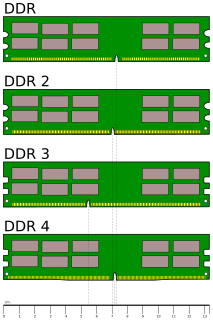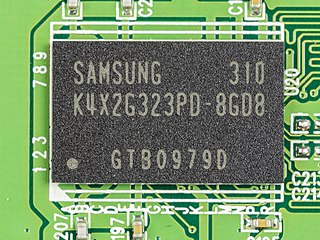
Double Data Rate Synchronous Dynamic Random-Access Memory, officially abbreviated as DDR SDRAM, is a double data rate (DDR) synchronous dynamic random-access memory (SDRAM) class of memory integrated circuits used in computers. DDR SDRAM, also retroactively called DDR1 SDRAM, has been superseded by DDR2 SDRAM, DDR3 SDRAM and DDR4 SDRAM. None of its successors are forward or backward compatible with DDR1 SDRAM, meaning DDR2, DDR3, and DDR4 memory modules will not work in DDR1-equipped motherboards, and vice versa.

Dynamic random-access memory (DRAM) is a type of random access semiconductor memory that stores each bit of data in a memory cell consisting of a tiny capacitor and a transistor, both typically based on metal-oxide-semiconductor (MOS) technology. The capacitor can either be charged or discharged; these two states are taken to represent the two values of a bit, conventionally called 0 and 1. The electric charge on the capacitors slowly leaks off, so without intervention the data on the chip would soon be lost. To prevent this, DRAM requires an external memory refresh circuit which periodically rewrites the data in the capacitors, restoring them to their original charge. This refresh process is the defining characteristic of dynamic random-access memory, in contrast to static random-access memory (SRAM) which does not require data to be refreshed. Unlike flash memory, DRAM is volatile memory, since it loses its data quickly when power is removed. However, DRAM does exhibit limited data remanence.

Synchronous dynamic random-access memory (SDRAM) is any dynamic random-access memory (DRAM) where the operation of its external pin interface is coordinated by an externally supplied clock signal.

A DIMM or dual in-line memory module comprises a series of dynamic random-access memory integrated circuits. These modules are mounted on a printed circuit board and designed for use in personal computers, workstations and servers. DIMMs began to replace SIMMs as the predominant type of memory module as Intel P5-based Pentium processors began to gain market share.
Rambus DRAM (RDRAM), and its successors Concurrent Rambus DRAM (CRDRAM) and Direct Rambus DRAM (DRDRAM), are types of synchronous dynamic random-access memory (SDRAM) developed by Rambus from the 1990s through to the early-2000s. The third-generation of Rambus DRAM, DRDRAM was replaced by XDR DRAM. Rambus DRAM was developed for high-bandwidth applications, and was positioned by Rambus as replacement for various types of contemporary memories, such as SDRAM.

Double Data Rate 2 Synchronous Dynamic Random-Access Memory, officially abbreviated as DDR2 SDRAM, is a double data rate synchronous dynamic random-access memory interface. It superseded the original DDR SDRAM specification, and is superseded by DDR3 SDRAM. DDR2 DIMMs are neither forward compatible with DDR3 nor backward compatible with DDR.

In computing, a computer bus operating with double data rate (DDR) transfers data on both the rising and falling edges of the clock signal. This is also known as double pumped, dual-pumped, and double transition. The term toggle mode is used in the context of NAND flash memory.
Column Access Strobe (CAS) latency, or CL, is the delay time between the READ command and the moment data is available. In asynchronous DRAM, the interval is specified in nanoseconds. In synchronous DRAM, the interval is specified in clock cycles. Because the latency is dependent upon a number of clock ticks instead of absolute time, the actual time for an SDRAM module to respond to a CAS event might vary between uses of the same module if the clock rate differs.
XDR DRAM or extreme data rate dynamic random-access memory is a high-performance RAM interface and successor to the Rambus RDRAM it is based on, competing with the rival DDR2 SDRAM and GDDR4 technology.
Double Data Rate 3 Synchronous Dynamic Random-Access Memory, officially abbreviated as DDR3 SDRAM, is a type of synchronous dynamic random-access memory (SDRAM) with a high bandwidth interface, and has been in use since 2007. It is the higher-speed successor to DDR and DDR2 and predecessor to DDR4 synchronous dynamic random-access memory (SDRAM) chips. DDR3 SDRAM is neither forward nor backward compatible with any earlier type of random-access memory (RAM) because of different signaling voltages, timings, and other factors.
Memory refresh is the process of periodically reading information from an area of computer memory and immediately rewriting the read information to the same area without modification, for the purpose of preserving the information. Memory refresh is a background maintenance process required during the operation of semiconductor dynamic random-access memory (DRAM), the most widely used type of computer memory, and in fact is the defining characteristic of this class of memory.

Fully Buffered DIMM is a memory technology that can be used to increase reliability and density of memory systems. Conventionally, data lines from the memory controller have to be connected to data lines in every DRAM module, i.e. via multidrop buses. As the memory width increases together with the access speed, the signal degrades at the interface between the bus and the device. This limits the speed and memory density, so FB-DIMMs take a different approach to solve the problem.
GDDR4 SGRAM, an abbreviation for double data rate type four synchronous graphics random access memory, is a type of graphics card memory specified by the JEDEC Semiconductor Memory Standard. It is a rival medium to Rambus's XDR DRAM. GDDR4 is based on DDR3 SDRAM technology and was intended to replace the DDR2-based GDDR3, but it ended up being replaced by GDDR5 within a year.
The memory controller is a digital circuit that manages the flow of data going to and from the computer's main memory. A memory controller can be a separate chip or integrated into another chip, such as being placed on the same die or as an integral part of a microprocessor; in the latter case, it is usually called an integrated memory controller (IMC). A memory controller is sometimes also called a memory chip controller (MCC) or a memory controller unit (MCU).

In computing, a memory module is a printed circuit board on which memory integrated circuits are mounted. Memory modules permit easy installation and replacement in electronic systems, especially computers such as personal computers, workstations, and servers. The first memory modules were proprietary designs that were specific to a model of computer from a specific manufacturer. Later, memory modules were standardized by organizations such as JEDEC and could be used in any system designed to use them.
Double Data Rate 4 Synchronous Dynamic Random-Access Memory, officially abbreviated as DDR4 SDRAM, is a type of synchronous dynamic random-access memory with a high bandwidth interface.

Random-access memory is a form of computer memory that can be read and changed in any order, typically used to store working data and machine code. A random-access memory device allows data items to be read or written in almost the same amount of time irrespective of the physical location of data inside the memory. In contrast, with other direct-access data storage media such as hard disks, CD-RWs, DVD-RWs and the older magnetic tapes and drum memory, the time required to read and write data items varies significantly depending on their physical locations on the recording medium, due to mechanical limitations such as media rotation speeds and arm movement.

Low-Power Double Data Rate Synchronous Dynamic Random Access Memory, commonly abbreviated as Low-Power DDR SDRAM or LPDDR SDRAM, is a type of double data rate synchronous dynamic random-access memory that consumes less power and is targeted for mobile computers. It is also known as Mobile DDR, and abbreviated as mDDR.
HyperCloud Memory (HCDIMM) is a DDR3 SDRAM Dual In-Line Memory Module (DIMM) used in server applications requiring a great deal of memory. It was initially launched in 2009 at the International Supercomputing Conference by Irvine, California based company, Netlist Inc. It was never a JEDEC standard, and the main server vendors supporting it were IBM and Hewlett Packard Enterprise.
Row hammer is a security exploit that takes advantage of an unintended and undesirable side effect in dynamic random-access memory (DRAM) in which memory cells leak their charges by interactions between themselves, possibly leaking or changing the contents of nearby memory rows that were not addressed in the original memory access. This bypass of the isolation between DRAM memory cells results from the high cell density in modern DRAM, and can be triggered by specially crafted memory access patterns that rapidly activate the same memory rows numerous times. While cell charge leakage is normal and mitigated by refreshes, additional leakage occurs during a rowhammer attack which causes cells to leak enough charge to change its content within a refresh interval.







